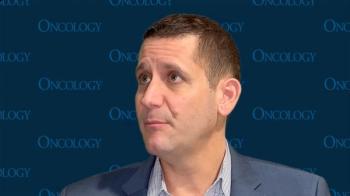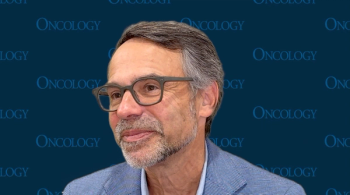
Tafasitamab Plus Lenalidomide Superior to Standard Therapies in Key Subgroups of High-Risk R/R DLBCL
Subgroup analysis of the RE-MIND trial support use of tafasitamab plus lenalidomide to treat high-risk diffuse large B-cell lymphoma.
A subgroup analysis of the observational RE-MIND2 study (NCT04697160) in patients with stem cell transplant–ineligible high-risk diffuse large B-cell lymphoma (DLBCL) suggests improved overall survival (OS) with tafasitamab (Monjuvi) plus lenalidomide (Revlimid) treatment vs selected systemic therapies, according to data presented at the
Using matched cohorts of patients in subgroups based on the number of extranodal sites and presence or absence of elevated lactate dehydrogenase (LDH) level, “the hazard ratio for OS suggests a trend toward favoring tafasitamab plus lenalidomide in each matched analysis set overall, and in most patient subgroups,” said lead investigator Grzegorz S. Nowakowski, MD, of the Division of Hematology at the Mayo Clinic in Rochester, Minnesota.
“In each subgroup examined, there was a trend favoring enhanced OS with tafasitamab plus lenalidomide when compared with systemic therapies pooled, rituximab [Rituxan] plus lenalidomide [Revlimid; R2], and polatuzumab [Polivy] plus bendamustine and rituximab [pola-BR].”1
For the tafasitamab plus lenalidomide versus systemic therapies pooled matched cohort comparison, median OS was:
- 34.1 months vs 11.6 months, respectively, in the overall cohort (HR, 0.553; 95% CI, 0.358-0.855; P = .0068).
- Not reached (NR) vs 14.5 months in those with 0 or 1 extranodal sites (HR, 0.476; 95% CI, 0.27-0.85).
- 14.8 vs 9.4 months in patients with 2 or more extranodal sites (HR, 0.803; 95 CI%, 0.40-1.61).
- NR vs 21.7 months in patients without elevated LDH (HR, 0.448; 95% CI, 0.21-0.96).
- 18.3 vs 8.3 months in those with elevated LDH (HR, 0.627; 95% CI, 0.37-1.07)
For the tafasitamab plus lenalidomide versus pola-BR matched cohort comparison, median OS was:
- 20.1 months vs 7.2 months, respectively, in the overall cohort (HR, 0.441; 95% CI, 0.203-0.956; P = .0340).
- 24.8 vs 8.5 months in those with 0 or 1 extranodal sites (HR, 0.573; 95% CI, 0.20-1.65).
- 7.6 vs 6.1 months in patients with 2 or more extranodal sites (HR, 0.524; 95% CI, 0.14-2.02).
- NR vs 8.5 months in patients without elevated LDH (HR, 0.388; 95% CI, 0.08-1.79).
- 11.6 vs 6.7 months in those with elevated LDH (HR, 0.585; 95% CI, 0.24-1.41).
For the tafasitamab plus lenalidomide vs R2 matched cohort comparison, median OS was:
- 24.6 months vs 7.4 months, respectively, in the overall cohort (HR, 0.435; 95% CI, 0.224-0.847; P = .0122).
- 31.6 months vs 9.5 months in those with 0 or 1 extranodal sites (HR, 0.491; 95% CI, 0.19-1.28).
- 24.6 months vs 6.2 months in patients with 2 or more extranodal sites (HR, 0.478; 95% CI, 0.17-1.34).
- NS vs NR in patients without elevated LDH (HR, 0.664; 95% CI, 0.15-3.01).
- 13.8 months vs 5.2 months in those with elevated LDH (HR, 0.420; 95% CI, 0.19-0.95).
For the tafasitamab plus lenalidomide versus CD19-directed CAR-T cell therapy matched cohort comparison, median OS was:
- 22.5 months vs 15.0 months, respectively, in the overall cohort (HR, 0.953; 95% CI, 0.475-1.913; P = .8929)
- 31.6 months vs 27.3 months in those with 0 or 1 extranodal sites (HR, 0.717; 95% CI, 0.28-1.85).
- 7.6 months vs 14.6 months in patients with 2 or more extranodal sites (HR, 1.459; 95% CI, 0.52-4.11)
- NR vs 14.6 months in patients without elevated LDH (HR, 0.371; 95% CI, 0.12-1.15).
- 8.6 vs 15.9 months in those with elevated LDH (HR, 1.663; 95% CI, 0.0.66-4.19).
“The observed trend of shorter OS duration of CAR-T cells versus tafasitamab plus lenalidomide in high-risk patients warrants further investigation,” said Dr. Nowakowski. “We note that analyses between tafasitamb and comparator therapies are not powered for statistical comparison. Small sample size resulted in wide confidence intervals; therefore, those results must be interpreted with caution.”
RE-MIND2 compared patient outcomes from the phase 2 L-MIND study (NCT02399085)2 with those from closely matched real-world cohorts, including patients treated with other systemic therapies for DLBCL pooled in a single cohort and cohorts comprising patients treated with common regimens.
Patients from L-MIND were closely matched with patients from 4 RE-MIND2 cohorts using estimated propensity score based one-to-one nearest neighbor matching balanced for up to 9 baseline covariates according to clinical relevance and other available patient records.
A total of 3454 patients were enrolled in RE-MIND2 from 200 study sites. The 1:1 matching methodology resulted in 76 pairs for tafasitamab plus lenalidomide versus systemic therapies pooled, 24 pairs versus pola-BR, 33 pairs versus R2, and 37 pairs versus CAR T-cell therapy.
The differences in cohort sizes reflects availability of baseline covariate data in hospital databases for therapies of interest, Nowakowski said.
Despite small sample sizes, “these results may aid in contextualizing therapy options for treating patients with R/R DBCL,” Nowakowski concluded.
References
- Salles G, Duell J, Barca EG, et al. Tafasitamab plus lenalidomide in relapsed or refractory diffuse large B-cell lymphoma (L-MIND): a multicentre, prospective, single-arm, phase 2 study. Lancet Oncol 2020;21(7):978-988. doi:10.1016/S1470-2045(20)30225-4
- Nowakowski GS, Yoon DH, Joffe E, et al. Subgroup analysis in RE-MIND2, an observational, retrospective cohort study of tafasitamab plus lenalidomide versus systemic therapies in patients with relapsed/refractory diffuse large B-cell lymphoma (R/R DLBCL). J Clin Oncol. 2022;40(suppl 16):Abstract 7560. doi:10.1200/JCO.2022.40.17_suppl.7560.
Newsletter
Stay up to date on recent advances in the multidisciplinary approach to cancer.
















































































